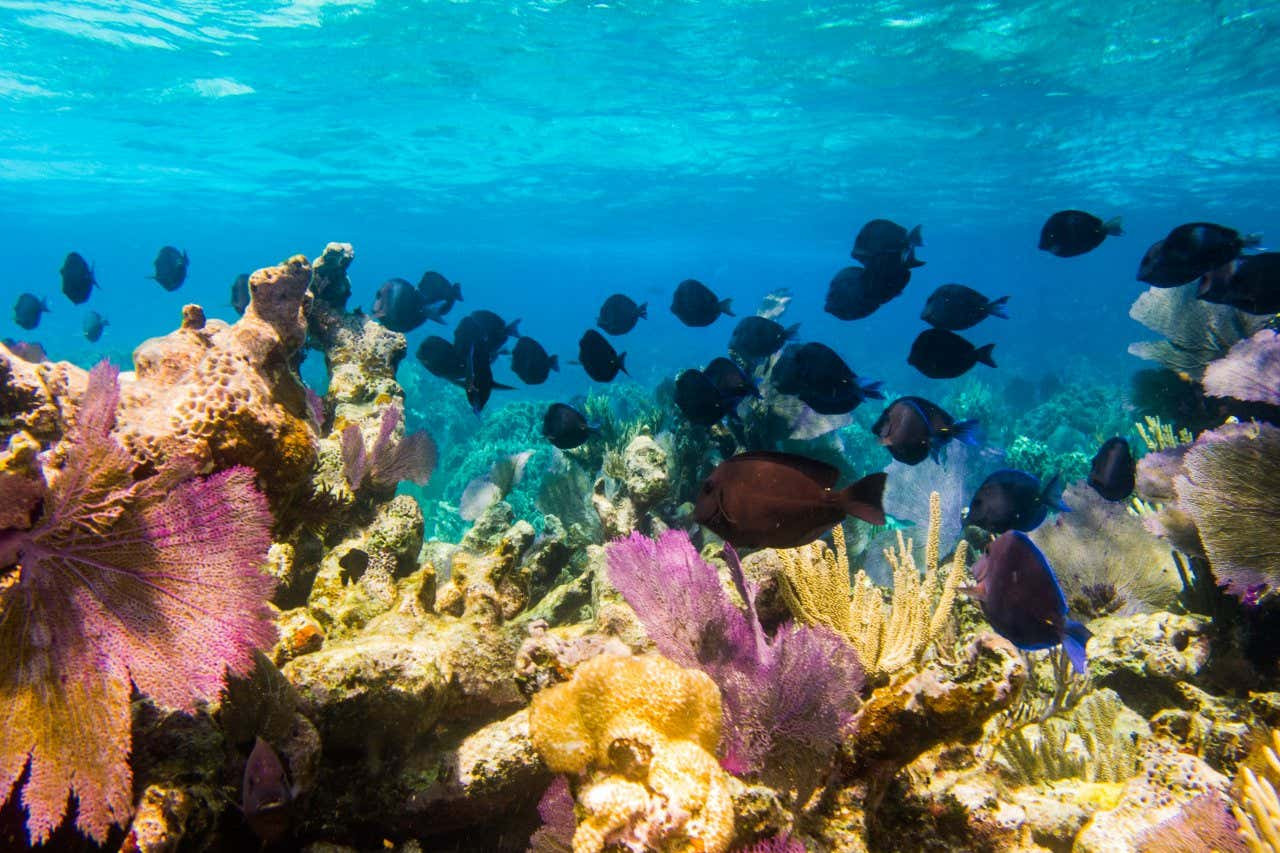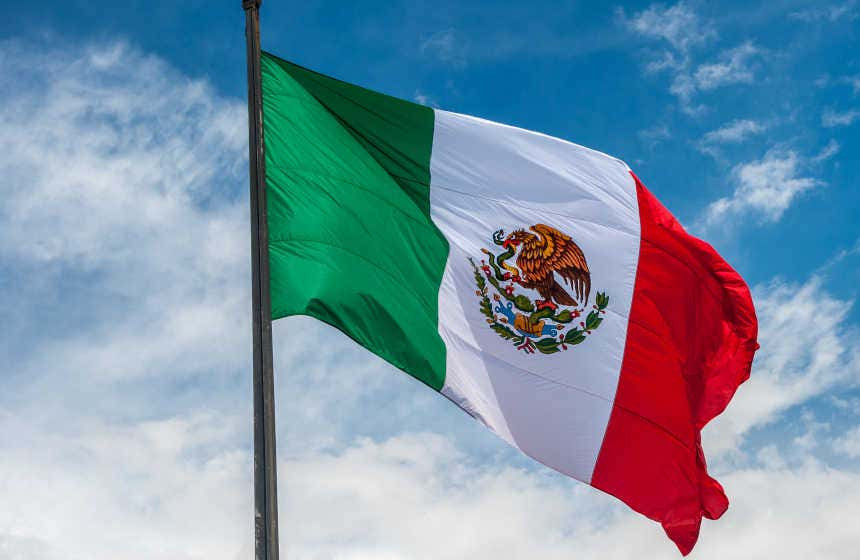Looking for some fun facts about Mexico? Gaymexico.net is your go-to resource for discovering the vibrant LGBTQ+ scene and hidden gems of this incredible country. Prepare to be amazed by Mexico’s rich culture, stunning landscapes, and fascinating history, with insights tailored for the LGBTQ+ traveler. Uncover unique destinations, explore exciting events, and connect with the LGBTQ+ community in Mexico today!
1. Is Mexico Home to the Second-Largest Coral Reef in the World?
Yes, Mexico is home to the Mesoamerican Reef System, the second-largest coral reef in the world after the Great Barrier Reef in Australia. This stunning barrier reef stretches 1,000 kilometers (621 miles) along the Caribbean coast, spanning Mexico, Belize, Guatemala, and Honduras. It’s a paradise for divers and snorkelers, offering breathtaking underwater views.
 Multiple fish swimming around the Mesoamerican Barrier Reef.
Multiple fish swimming around the Mesoamerican Barrier Reef.
The Mesoamerican Reef is renowned for its incredible biodiversity. Divers can explore a vibrant ecosystem teeming with colorful fish, sea turtles, and a variety of coral species. According to the World Wildlife Fund (WWF), the reef provides critical habitat for over 500 species of fish and 60 species of coral. For LGBTQ+ travelers seeking adventure, many tour operators in the Riviera Maya offer excursions to Isla Mujeres by catamaran, providing an unforgettable experience to explore the reef. Swimming with whale sharks, which visit these waters between May and September, is a thrilling experience for risk-takers. These gentle giants can reach up to 12 meters (39 feet) in length.
2. Are There 68 Recognized Languages in Mexico?
Yes, Mexico recognizes 68 languages, showcasing its rich cultural diversity. While over 99% of the population speaks Spanish, the Constitution of Mexico does not declare an official language. This recognition underscores the importance of indigenous cultures and their linguistic heritage.
Mexico’s linguistic diversity is a testament to its multicultural heritage. According to the National Institute of Indigenous Languages (INALI), the 63 indigenous languages are spoken by millions of people across the country. Many of these languages are endangered, making their preservation a crucial part of Mexico’s cultural policy. For LGBTQ+ individuals interested in cultural immersion, learning a few phrases in an indigenous language can be a meaningful way to connect with local communities. Several organizations offer language classes and cultural exchange programs that promote understanding and respect for Mexico’s diverse linguistic landscape.
3. Does Mexico City Have the 2nd Most Museums in the World?
Yes, Mexico City boasts 170 museums, making it second only to London in the number of museums worldwide. This makes it a must-visit destination for museum enthusiasts.
Mexico City’s museums cater to a wide range of interests, from ancient history to contemporary art. The National Museum of Anthropology houses the world’s largest collection of ancient Mexican art. The Frida Kahlo Museum offers an intimate look into the life and work of the iconic artist. According to a study by the Mexico City Tourism Trust, museums are a major draw for tourists. In 2024, the city’s museums attracted over 10 million visitors. For LGBTQ+ travelers, Mexico City’s vibrant art scene and inclusive atmosphere make it a welcoming and enriching destination. Many museums feature exhibits that explore themes of identity, diversity, and social justice.
4. Does Mexico Have 35 UNESCO World Heritage Sites?
Yes, Mexico is home to 35 UNESCO World Heritage Sites, reflecting its rich cultural and natural history. These sites include 27 cultural sites, 6 natural sites, and 2 mixed sites, showcasing the country’s diverse heritage.
Mexico’s UNESCO World Heritage Sites are a testament to its historical and ecological significance. The historic center of Mexico City and Xochimilco were the first sites to be declared in 1987. Other notable sites include the ancient city of Teotihuacan, the Mayan city of Chichen Itza, and the Monarch Butterfly Biosphere Reserve. According to UNESCO, these sites are recognized for their outstanding universal value and are protected for future generations. For LGBTQ+ travelers, exploring these sites offers a chance to connect with Mexico’s rich history and cultural traditions. Many tours are available, including night tours of Xochimilco, offering unique perspectives on these iconic destinations.
 Xochimilco canal with people sailing down it on colourful boats.
Xochimilco canal with people sailing down it on colourful boats.
5. Was The Day of The Dead’s La Catrina Created as a Satire?
Yes, La Catrina, the iconic image associated with The Day of the Dead, was originally created as a satire by José Guadalupe Posada. It referenced the high-society European obsessions of Porfirio Diaz.
La Catrina has become a symbol of The Day of the Dead, representing the Mexican perspective on death and the afterlife. José Guadalupe Posada’s satirical creation was meant to critique the upper class’s imitation of European customs. Today, La Catrina is celebrated as a cultural icon, embodying the spirit of the holiday. According to the National Museum of Mexican Art, La Catrina represents the idea that death is a great equalizer, reminding everyone of their mortality. For LGBTQ+ travelers, experiencing The Day of the Dead in Mexico City offers a profound cultural immersion. Night tours during the festival provide unique insights into the traditions and symbolism of this important holiday.
 Multiple figures with the typical La Catrina skull design in front of a red wall with skulls and guitars on it as decoration.
Multiple figures with the typical La Catrina skull design in front of a red wall with skulls and guitars on it as decoration.
6. Does Mexico Have the Largest University in Latin America?
Yes, the National Autonomous University of Mexico (UNAM) is the largest university in Latin America. Founded in 1551, UNAM has multiple campuses across Mexico City.
UNAM is not only the largest but also one of the most prestigious universities in the world. It’s recognized for its extensive research and academic excellence. According to the QS World University Rankings, UNAM consistently ranks among the top universities in Latin America. The university’s main campus is a UNESCO World Heritage Site, known for its stunning architecture and cultural significance. For LGBTQ+ individuals interested in education and culture, visiting UNAM offers a glimpse into Mexico’s intellectual heritage. The university’s inclusive environment and diverse student body make it a welcoming space for all.
7. Is There a Park with Ruins from the Mesoamerican Pre-Classical Period?
Yes, Chapultepec Park in Mexico City features ruins dating back to the Mesoamerican pre-classical period. This expansive park, spanning over 678 hectares, is filled with historical remnants.
Chapultepec Park is one of the largest urban parks in the world, offering a blend of history, culture, and recreation. Within its grounds, you can find the National Museum of Anthropology, the National Auditorium, and Chapultepec Castle. According to the Mexico City government, the park attracts millions of visitors each year. Chapultepec has been a significant site since pre-Hispanic times, serving as a retreat for Aztec rulers. For LGBTQ+ travelers, exploring Chapultepec Park provides a chance to connect with Mexico’s ancient past and enjoy the natural beauty of the city. Free tours of the Chapultepec forest offer insights into the park’s hidden gems and historical significance.
 An aerial view of Chapultepec park with Mexico City seen across it.
An aerial view of Chapultepec park with Mexico City seen across it.
8. Is The Flag Full of Symbolism?
Yes, the Mexican flag is rich in symbolism, with each element representing significant aspects of the country’s history and identity. The three vertical stripes—green, white, and red—have evolved in meaning over time.
The colors of the Mexican flag are said to represent hope (green), unity (white), and the blood shed by national heroes (red). The central emblem depicts an eagle devouring a snake perched on a cactus, symbolizing the legend of the founding of Tenochtitlan (present-day Mexico City). According to the Mexican government, the flag is a symbol of national pride and patriotism. For LGBTQ+ individuals, the flag represents the country’s evolving identity and the ongoing pursuit of equality and inclusion. Guided tours of the Museo del Templo Mayor de Tenochtitlan offer a deeper understanding of the civilization behind the flag’s emblem.
 A close-up of the Mexican flag with a blue sky and some clouds behind it.
A close-up of the Mexican flag with a blue sky and some clouds behind it.
9. Volcanoes and Mythology: Is This True?
Yes, the Iztaccíhuatl and Popocatépetl volcanoes in Puebla are steeped in mythology. According to the Tlaxcala people, they represent the princess Iztaccíhuatl and the warrior Popocatépetl, destined to remain together until the end of time.
These volcanoes, located in Izta-Popo Zoquiapan National Park, are considered sacred sites. Exceeding 5,000 meters (16,404 feet) in altitude, they dominate the landscape. According to local legends, the volcanoes were once deities and servants of the rain god Tlaloc. Archaeological sites in the caves surrounding the volcanoes provide evidence of ancient rituals. For LGBTQ+ travelers seeking natural beauty and cultural experiences, an excursion to the Popocatépetl and Iztaccíhuatl Volcanoes offers breathtaking scenery and a connection to Mexico’s indigenous heritage.
10. Did Mexico Bring Chocolate to Europe?
Yes, Mexico brought chocolate to Europe. Ancient Mexican civilizations, including the Olmecs, Aztecs, and Maya, cultivated cacao trees for over 3,000 years.
Chocolate held significant cultural and economic value in pre-Columbian Mexico. After the Spanish conquest of the Aztec Empire, chocolate was introduced to Europe, where it became a luxury item. According to the National Museum of Anthropology, cacao beans were used as currency and in religious ceremonies. For LGBTQ+ travelers interested in culinary traditions, attending a chocolate workshop in Mexico City provides insights into Mexico’s chocolate heritage and the art of chocolate making.
 A close-up of someone
A close-up of someone
11. Is Mexico Home to One of The World’s Largest Pyramids?
Yes, Mexico is home to one of the world’s largest pyramids: the Great Pyramid at Cholula. This pyramid is the largest by volume known to exist today.
The Great Pyramid at Cholula is an impressive archaeological site, though it may not be the tallest pyramid. When the Spanish conquered the city, they initially mistook it for a hill due to its massive size. According to archaeological studies, the pyramid was built over centuries by various Mesoamerican cultures. For LGBTQ+ travelers exploring Mexico’s historical sites, a day trip from Mexico City to Cholula offers a chance to witness this incredible structure and learn about its cultural significance.
 The Great Pyramid at Cholula seen on a sunny day with grass around it.
The Great Pyramid at Cholula seen on a sunny day with grass around it.
5 Key Search Intentions for “What Are Some Fun Facts About Mexico”
- Informational: Users seek general knowledge about Mexico’s culture, history, and geography.
- Travel Planning: Users want to discover interesting places and activities to experience during a trip to Mexico.
- Cultural Understanding: Users aim to learn about Mexico’s traditions, customs, and unique aspects of its society.
- Educational: Users look for fun facts to share with others or to satisfy their curiosity about Mexico.
- Entertainment: Users desire light-hearted and engaging content about Mexico that is both informative and enjoyable.
FAQ About Fun Facts About Mexico
- What is one of the most surprising fun facts about Mexico?
One surprising fact is that the Great Pyramid at Cholula is the largest pyramid by volume in the world, often mistaken for a hill due to its size. - Are there any fun facts about Mexico’s languages?
Yes, while Spanish is widely spoken, Mexico recognizes 68 languages, including 63 indigenous languages, highlighting its linguistic diversity. - What Are Some Fun Facts About Mexico City’s cultural attractions?
Mexico City boasts the second-highest number of museums globally, with 170 museums, offering a rich cultural experience. - Can you share a fun fact about Mexico’s natural wonders?
Mexico is home to the Mesoamerican Reef System, the second-largest coral reef in the world, teeming with diverse marine life. - What’s a fun fact related to Mexican traditions?
The iconic La Catrina from The Day of the Dead was originally created as a satire referencing European obsessions. - Do you know any fun facts about Mexico’s educational institutions?
The National Autonomous University of Mexico (UNAM) is the largest university in Latin America and a UNESCO World Heritage Site. - Are there any fun facts about historical sites in Mexico City?
Chapultepec Park in Mexico City contains ruins from the Mesoamerican pre-classical period, blending history with natural beauty. - What is a fun fact about the symbolism behind the Mexican flag?
The Mexican flag’s emblem represents the legend of the founding of Tenochtitlan, with an eagle devouring a snake on a cactus. - Can you share a fun fact about Mexico’s legends and mythology?
The Iztaccíhuatl and Popocatépetl volcanoes are believed to represent a princess and a warrior who will remain together until the end of time. - What is a fun fact about Mexico’s culinary history?
Mexico introduced chocolate to Europe, with ancient civilizations cultivating cacao trees for over 3,000 years.
Discover even more fascinating insights and plan your next adventure with gaymexico.net. From detailed travel guides to insider tips on LGBTQ+ friendly destinations and events, we’re here to help you explore Mexico safely and authentically. Connect with the LGBTQ+ community, uncover hidden gems, and create unforgettable memories in this incredible country. Visit gaymexico.net today and start your journey.
Address: 3255 Wilshire Blvd, Los Angeles, CA 90010, United States.
Phone: +1 (213) 380-2177
Website: gaymexico.net
